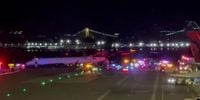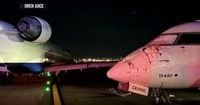On the evening of October 1, 2025, a routine night at New York’s LaGuardia Airport took a dramatic turn when two Delta Air Lines regional jets collided on a taxiway, leaving one flight attendant injured and both aircraft significantly damaged. The incident, described by Delta as a "low-speed collision," has since triggered investigations by the Federal Aviation Administration (FAA) and the National Transportation Safety Board (NTSB), raising fresh concerns about ground safety at one of the nation’s busiest airports.
It all unfolded around 10 p.m., as Endeavor Air Flight 5155, a Delta Connection CRJ-900 regional jet, was preparing for takeoff to Roanoke, Virginia. The aircraft, carrying 28 passengers and four crew members, was taxiing when its wing struck the fuselage of another Endeavor Air CRJ-900, Flight 5047, which had just arrived from Charlotte, North Carolina, with 57 passengers and four crew members on board, according to statements from Delta and the Port Authority of New York and New Jersey.
The impact was immediate and jarring. Images from the scene showed the right wing of Flight 5155 broken, while the cockpit window of Flight 5047 was shattered and its nose deeply gouged. "Their right wing clipped our nose and the cockpit. We have damage to our windscreen and ... some of our screens in here," a pilot reported over air traffic control, as posted by LiveATC.net. The severity of the damage was clear, but fortunately, the speeds involved were not believed to be a major factor, as officials emphasized the collision occurred at a low velocity.
Inside the cabin, passengers sat in stunned silence. William Lusk, a passenger aboard the arriving flight, recounted to ABC, "The plane that had landed stopped, jerked, and jumped to the right. Everyone went dead silent. And as everyone went dead silent, the pilot calmly came on and said, ‘Hey, we've been in a crash, everyone remain calm.'"
Though no passengers were hurt, the collision did result in injury to a flight attendant, who reportedly struck her knee during the impact and was transported to a local hospital for treatment, as confirmed by the Port Authority. "A flight attendant was taken to a hospital," the agency stated, and one of the pilots relayed, "the flight attendant told him she hit her knee when the planes collided." The airline assured that all passengers were unharmed and later provided meals, hotel accommodations, and rebooked flights for those affected, ensuring their travel continued the following day.
As news of the incident spread, attention quickly turned to how such a mishap could occur at an airport equipped with advanced safety technology. LaGuardia is among 35 major U.S. airports where the FAA has installed sophisticated surface radar systems designed to track aircraft and vehicles on the ground, alerting controllers to potential conflicts. Yet, it remains unclear what role, if any, this system played in the collision. Aviation safety consultant and former NTSB and FAA crash investigator Jeff Guzzetti explained to the Associated Press that while controllers are responsible for keeping runways clear, pilots must maintain "situational awareness about where your wings are poking out at and what they could hit as you’re taxiing." He added, "They (controllers) expect the flight crews to see each other since they’re taxiing at a slow speed. And the controller's main function is to make sure the runway is clear for takeoff and landings."
Visibility may have also been a complicating factor. According to Guzzetti, because the incident happened at night, pilots typically switch off their nose lights while taxiing to avoid blinding others, relying instead on taxi lights mounted on the wings. While landing lights can improve visibility, the FAA cautions pilots to use them judiciously to prevent impairing the night vision of others. This delicate balance might have made it tougher for the pilots to spot each other on the darkened taxiway.
Responsibility for the collision is still being determined. The FAA revealed that air traffic control had instructed the Virginia-bound Flight 5155 "to hold short and yield to the other aircraft" before the collision. The agency’s statement reads, "Endeavor Air Flight 5047, a CRJ-900, was taxiing inbound to its gate at LaGuardia Airport in New York when it struck Endeavor Air Flight 5155, also a CRJ-900. Air traffic control instructed flight 5155 to hold short and yield to the other aircraft." Investigators are now poring over cockpit voice recordings and flight data, both of which have been recovered and sent to NTSB headquarters for analysis. The NTSB has dispatched a team of 10 experts to LaGuardia to conduct a thorough investigation.
The collision comes at a time of heightened scrutiny for aviation safety in the United States. Recent years have seen a series of near misses and, in one case, the deadliest plane crash in decades, when an Army helicopter collided with an airliner at Ronald Reagan Washington National Airport. Each incident raises the stakes for airlines, regulators, and airport operators to ensure that even low-speed ground movements are managed with the utmost care.
Both aircraft involved in the LaGuardia incident were CRJ-900 regional jets, seating between 70 and 90 passengers, and operated by Delta’s regional partner, Endeavor Air. Delta, for its part, has pledged full cooperation with authorities. "Delta will work with all relevant authorities to review what occurred as safety of our customers and people comes before all else," the airline said in a statement. "We apologize to our customers for the experience."
For the travelers involved, the ordeal was disruptive but, ultimately, not catastrophic. After deplaning, they were provided with meals and hotel rooms, and Delta arranged for them to continue their journeys on October 2. The flight attendant’s injury, though not life-threatening, serves as a reminder that even incidents on the ground can have real consequences for those on board.
As the investigation unfolds, the aviation community will be watching closely for answers—and for lessons that might prevent another close call. For now, the incident stands as a sobering example of the complexities and risks that persist even when planes are moving slowly, far from the drama of takeoff or landing. The story at LaGuardia is still developing, but one thing is certain: safety on the ground is every bit as crucial as safety in the skies.


